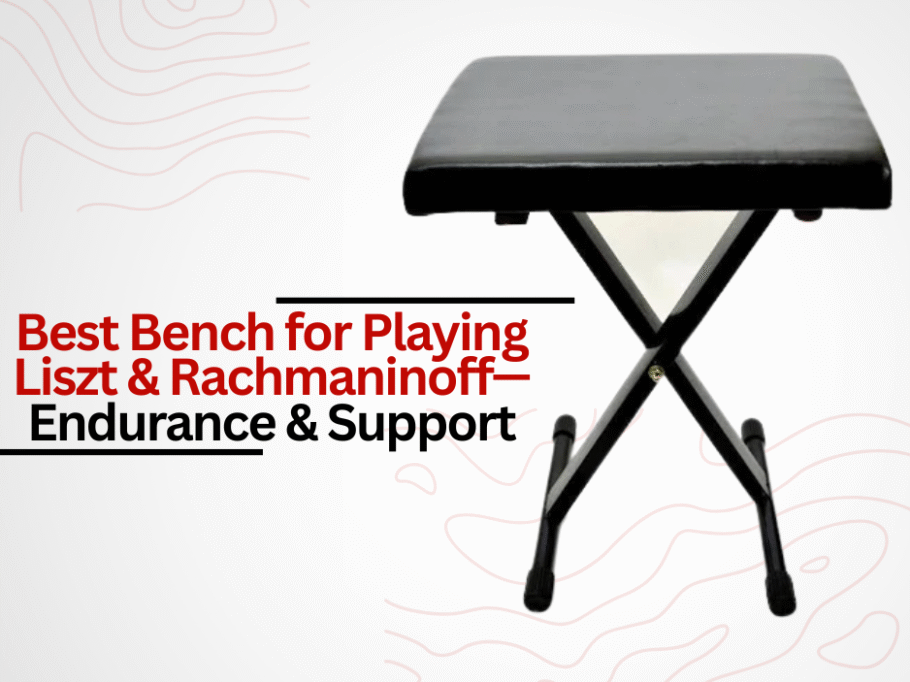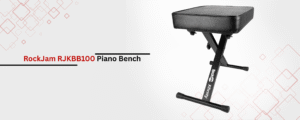While playing the works of both Liszt and Rachmaninoff, it is vital to have proper endurance and to remain physically supported while playing. As powerful pianists, Liszt and Rachmaninoff required copious strength, dexterity, and seamless motion. Simply picking the right piano bench for virtuoso pieces can be the decisive factor in winning the battle between performance and enduring fatigue while playing virtuoso pieces. With the right setup, one’s posture, techniques, and technical capabilities can be maintained while unrestricted artistic interpretation can be achieved.
Why the Right Bench for Virtuoso Repertoire?
Physical Requirements of Liszt and Rachmaninoff:
The works of both Liszt and Rachmaninoff feature wide intervals, quick shifts in dynamics, and long sustained energy periods. Without a suitable bench for the demanding repertoire, pianists may encounter muscle strain, postural collapse, and lack of endurance.
Impact on Endurance and Postural Alignment:
Encouraged seating allows the pianist an open chest while achieving relaxed shoulders and flexible wrists. These collective factors enable effortless and strain-free expressive performances.
Improving Technical Execution:
The staggering runs of Liszt or the rich chordal textures of Rachmaninoff are but some examples of complex passages a pianist could tackle if the player’s body balance and alignment with the piano are set correctly. With the right design, a bench will enable the arms to move freely, the pedals to be used in a controlled manner, and the fingers to move firmly yet gently.
Key Features of a Good Piano Bench for Demanding Repertoire
Height Adjustment Feature:
Each piece presents its own set of challenges, especially for different pianists, which makes customized height settings essential. A bench intended for virtuosic pieces must provide precise height adjustments sufficient to match the player’s optimal playing posture.
Solid Construction:
Stably reframed benches ensure that the weighty frame will not easily get disturbed during intense passages. During complicated sequences, wobbling or shifting would pose an injury risk.
High-Density Cushioning:
Hours of practice on pieces by Liszt or Rachmaninoff can be relentless. Thick, supportive padding is a must, without which discomfort settles in all too quickly, negatively influencing practice or performance.
Ergonomic Design:
Optimal design promotes increased pelvic positioning as well as ideal spine and neck alignment, which is crucial to stave off early onset fatigue while encouraging movement and versatility.
Adjusting the Bench Height for Endurance and Power
Seat Height and Arm Angle:
The bench should be adjusted so ears are slightly above the blue line with a hand resting on the keyboard. In addition, the wrist must be able to move freely, and the hand relaxed. This positioning gives the leverage that is needed for powerful fortissimo passages and delicate pianissimo runs alike.
Distance From the Keyboard:
In this scenario, the pianist should be placed far enough away as to permit free movement of the upper arms without locking the elbows but close enough to the instrument to fully control its expressive capabilities.
Foot Position for The Control of Pedals:
Both feet shall be placed properly so that the pedals may be accessed without altering the body’s center of balance. Any changes in pedal control must be well supported by the bench, which enables achieving lush textures in demanding pieces, typical of Rachmaninoff.
Best Piano Benches for Playing Liszt and Rachmaninoff
5 Core KBB HD Piano Bench:
The 5 Core KBB HD Piano Bench places heavy consideration on comfort with its 2-inch padded seat. Their heavy-duty steel frame is designed for structural stability. The bench offers 4 height adjustment options from 14.5 to 20.5”, so proper ergonomic posture is maintained for any pianist during extended play. The heavy-duty X-style steel frame provides excellent stability and supports up to 340 lbs, making it suitable for a wide range of users. Non-slip rubber end caps keep the bench securely in place and protect floors from scratches.
Pros:
- Multiple height adjustment ranges (14.5 to 20.5 inches) allow for precise ergonomic customization, supporting optimal posture for players of any age or size.
- Flexible design easily accommodates both seated and standing playing positions, adapting to various instruments and performance needs.
- Extra-thick, high-density 3-inch cushioning delivers superior comfort and maintains its shape, reducing fatigue during long sessions.
- Rugged metal alloy X-frame ensures exceptional stability and long-term durability, even with frequent use.
- Impressive weight capacity of up to 340 lbs allows the bench to comfortably support a broad range of users and playing scenarios.
- Outstanding value for money, offering premium features and robust construction at one of the most accessible price points in its class.
Cons:
- Overall, I liked the piano bench. I was expecting 3 days of delivery, but I received it after 4 days, which is negligible.
Upgrade your practice and performance setup—choose a piano bench that delivers ergonomic comfort and reliable support.
Find the ideal piano bench for your space and playing style—explore adjustable, cushioned options built for lasting use.
RockJam RJKBB100 Piano Bench:
The padded seat combines beautifully with a steel frame on the RockJam RJKBB100 bench, making it easy to transport through long sessions. The adjustable height also makes it ideal for relaxing seating during grueling practice sessions.
Pros:
- Thick, premium padding provides lasting comfort for extended playing.
- Highly adjustable with four quick height settings for optimal posture and reduced fatigue
- Folds flat for effortless storage and portability, ideal for gigs or small spaces.
- Non-slip rubber feet keep the bench stable on any surface and protect floors from damage.
Cons:
- No built-in storage compartment for sheet music or accessories.
- May feel narrow for larger users or those who prefer a wider seat.
- Limited height range may not be suitable for very tall players.
Roland RPB-300BK Piano Bench:
The Roland RPB300BK bench has a wooden frame and a soft seat, making it well suited for intense practice and show sessions while holding true to traditional appeal.
Pros:
- Great Value Construction: Premium bench with a solid wood frame that resists splitting and retains a prestigious touch.
- Vintage Charm: The finish enhances the charm of both classic and contemporary interiors.
- Comfortable Seating: The soft, padded seat provides support for extended playing sessions without discomfort.
Cons:
- No built-in storage compartment for sheet music or accessories.
- Lacks Multiple Height Adjustments.
Conclusion
Achieving the astounding artistry of Liszt and Rachmaninoff starts with getting the fundamentals right; in this case, it begins with the right piano bench. A well-adjusted piano bench provides the necessary comfort for virtuosic pieces, supports stamina, encourages proper posture, and elevates technical performance during extreme musical difficulties.
Brands like 5 Core, Roland, and RockJam have earned a reputation as reliable providers of quality instruments, and their options for serious musicians are exceptional. Like everything else, we cannot predict what the future holds for us.






